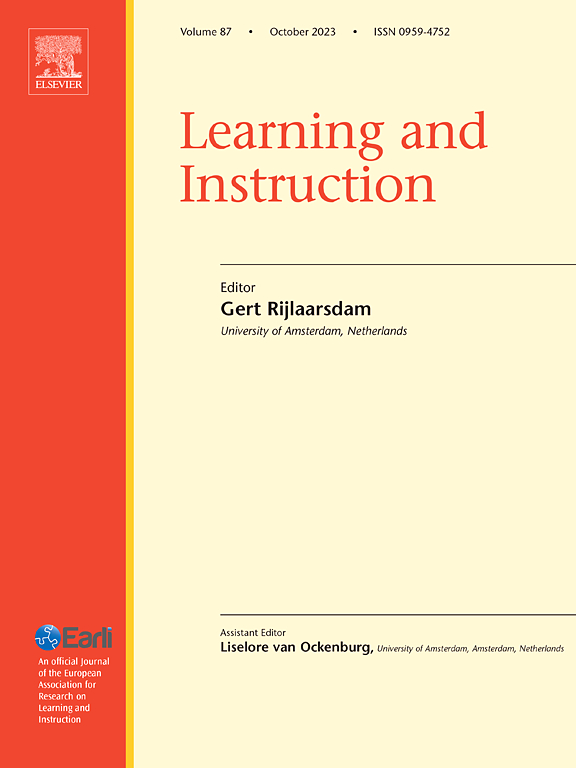探索自主学习中的创造力及其与学习成绩的关系
IF 4.9
1区 教育学
Q1 EDUCATION & EDUCATIONAL RESEARCH
引用次数: 0
摘要
尽管全球都认识到在教育中培养创造力的重要性,但对学习过程中的创造力的认识还存在差距。目的研究自我调节学习中创造性在学生学习策略使用中的表现及其与自我效能感和学习成绩的关系。具体而言,我们探讨了创造力的四个指标(流利性、灵活性、独创性和有用性)与自我监控之间的关系,并研究了这些指标如何影响自我效能感和学习成绩。样本参与者为100名来自一年级心理统计班的本科生(年龄= 19.48岁;SD = 0.86; 70%为女性)。方法在期末考试前14天采用日记的方法,参与者每天记录他们的学习策略,并评估他们的自我监控和学业自我效能。期末考试成绩被记录为学习成绩。学习策略应用中的创造力被归类为四个指标:流利性(使用策略的数量)、灵活性(策略类别和类别转换的数量)、独创性(策略的独特性)和有用性(策略的感知有效性)。结果动态结构方程模型显示,流利性和灵活性(类别数)正预测次日自我监测,而自我监测正预测次日灵活性(类别切换)和有用性。回归分析显示流畅性、灵活性(类别数和转换)、有用性和学习成绩之间存在显著的正相关。学业自我效能在流利性、灵活性(类别数)、独创性、有用性和学业成绩之间起中介作用。结论本研究揭示了创造性维度在中小学生学习策略应用中的作用,揭示了创造性与自我监控和自我效能感的动态交互作用对学业成绩的影响。本文章由计算机程序翻译,如有差异,请以英文原文为准。
Exploring creativity in self-regulated learning and its association with academic performance
Background
Despite global acknowledgment of the importance of fostering creativity in education, there is a gap in understanding creativity in learning process.
Aims
This study examines how creativity manifests in students’ use of learning strategies within self-regulated learning (SRL) and how it relates to self-efficacy and academic performance. Specifically, we explore the relations between four indicators of creativity (fluency, flexibility, originality, and usefulness) and self-monitoring, and examine how these indicators influence self-efficacy and academic performance.
Sample
Participants were 100 undergraduate students (Mage = 19.48 years; SD = 0.86; 70 % female) from a first-year psychological statistics class.
Methods
Using a diary approach over 14 days before the final exam, participants documented their learning strategies and assessed their self-monitoring and academic self-efficacy daily. Final exam scores were recorded as academic performance. Creativity in the application of learning strategies was codified into four indicators: fluency (number of strategies used), flexibility (number of strategy categories and category switches), originality (uniqueness of strategies), and usefulness (perceived effectiveness of strategies).
Results
Dynamic structural equation models indicated that fluency and flexibility (category number) positively predicted next-day self-monitoring, while self-monitoring predicted next-day flexibility (category switch) and usefulness. Regression analyses showed significant positive relations between fluency, flexibility (category number and switch), usefulness, and academic performance. Academic self-efficacy mediated the relation between fluency, flexibility (category number), originality, usefulness, and academic performance.
Conclusion
This study illuminates the creative dimension in the application of learning strategies within SRL, highlighting how creativity dynamically interacts with self-monitoring and self-efficacy to enhance academic performance.
求助全文
通过发布文献求助,成功后即可免费获取论文全文。
去求助
来源期刊

Learning and Instruction
Multiple-
CiteScore
11.30
自引率
4.80%
发文量
109
期刊介绍:
As an international, multi-disciplinary, peer-refereed journal, Learning and Instruction provides a platform for the publication of the most advanced scientific research in the areas of learning, development, instruction and teaching. The journal welcomes original empirical investigations. The papers may represent a variety of theoretical perspectives and different methodological approaches. They may refer to any age level, from infants to adults and to a diversity of learning and instructional settings, from laboratory experiments to field studies. The major criteria in the review and the selection process concern the significance of the contribution to the area of learning and instruction, and the rigor of the study.
 求助内容:
求助内容: 应助结果提醒方式:
应助结果提醒方式:


